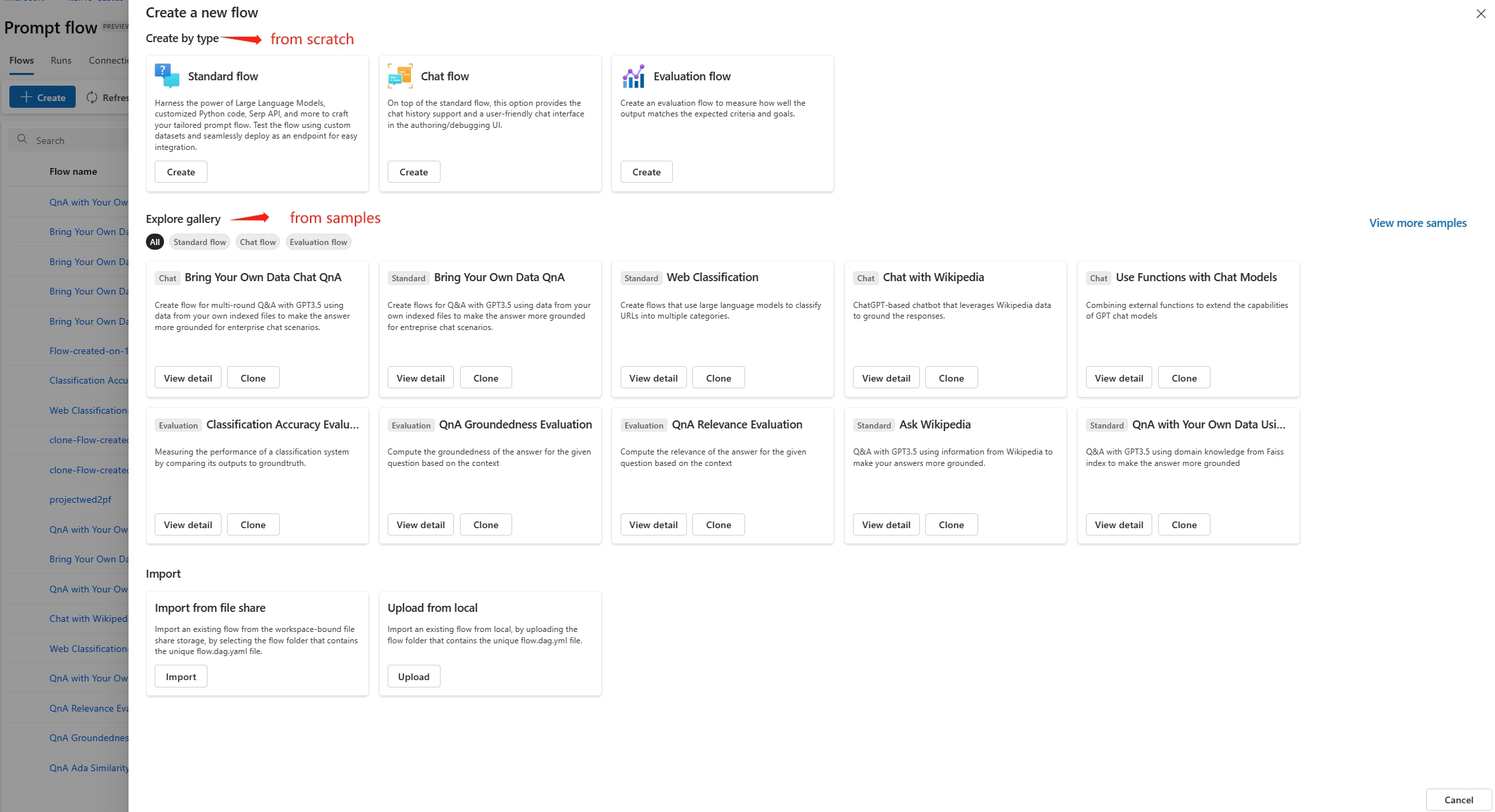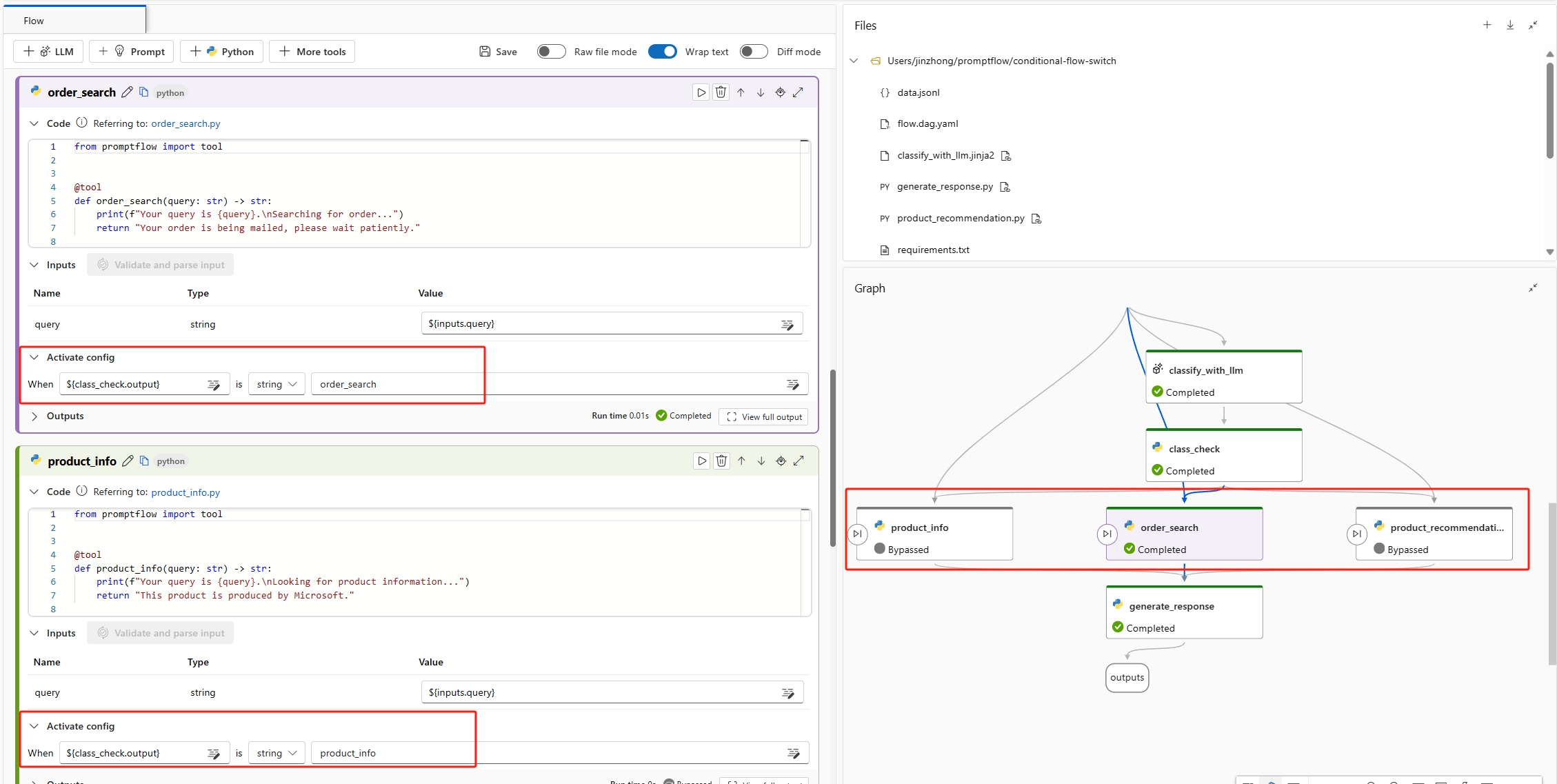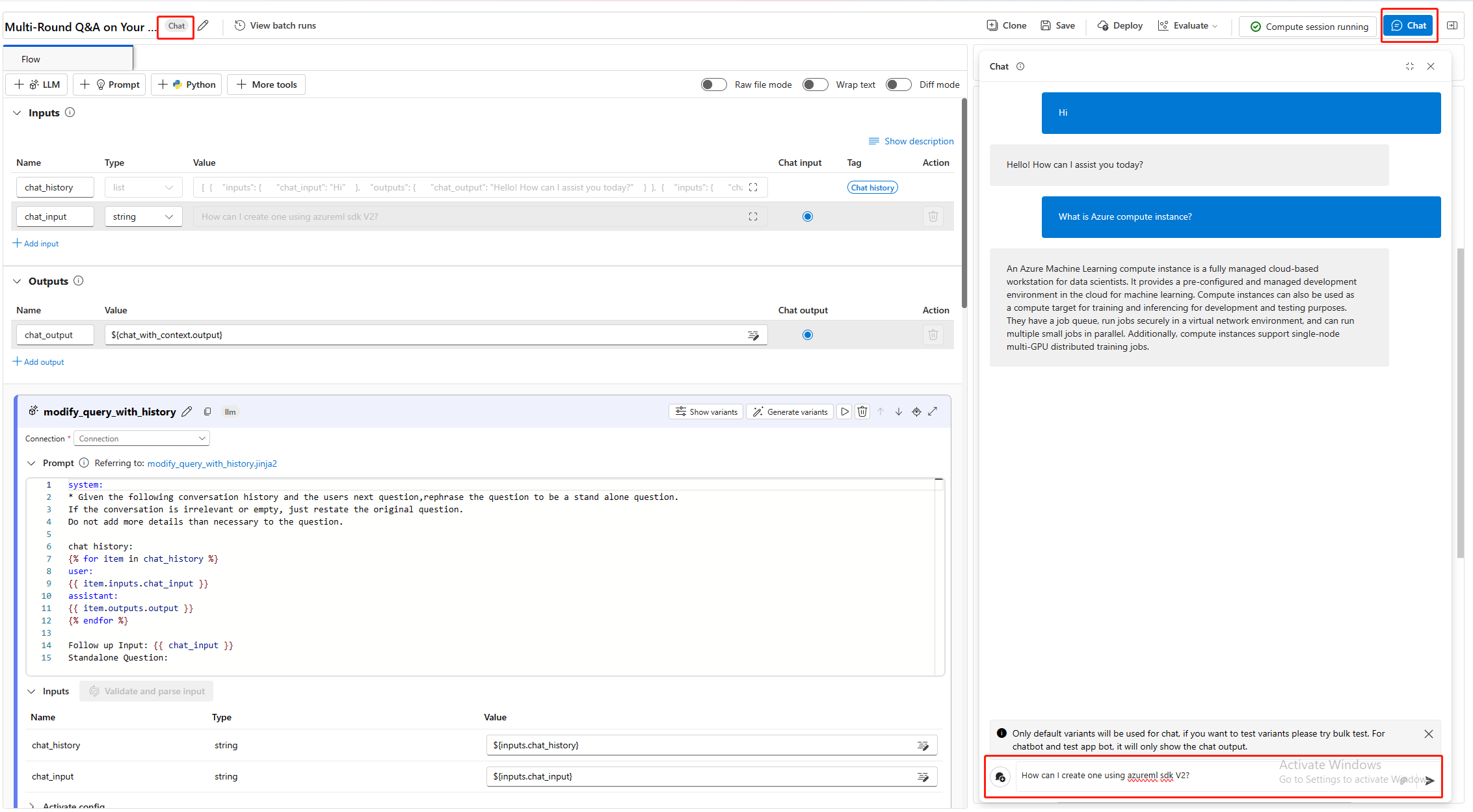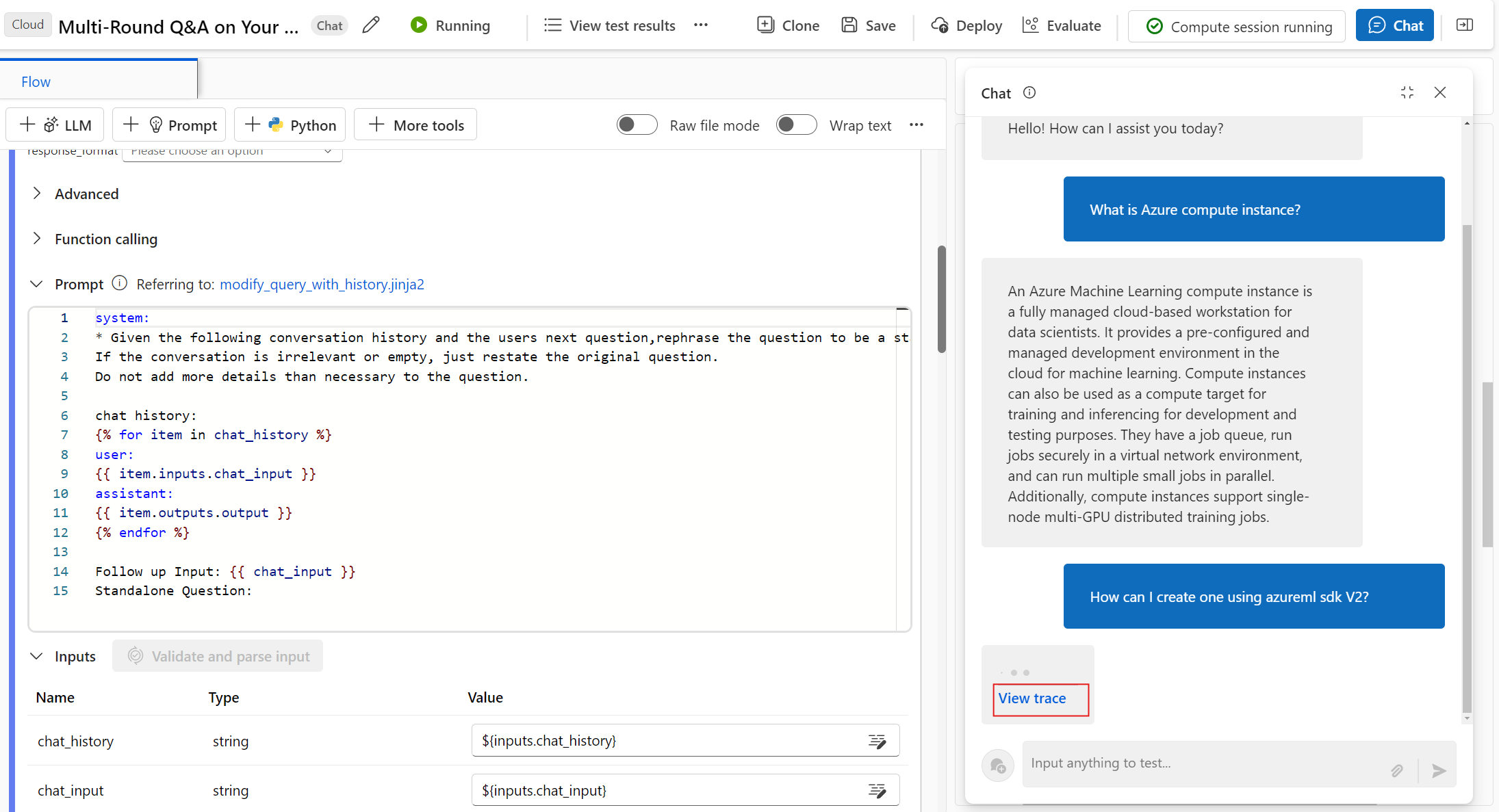Note
Access to this page requires authorization. You can try signing in or changing directories.
Access to this page requires authorization. You can try changing directories.
Prompt flow is a development tool that streamlines the development cycle of AI applications that are powered by Large Language Models (LLMs). In this article, you learn how to create and develop a prompt flow and a chat flow in Azure Machine Learning studio.
As the momentum for LLM-based AI applications grows, prompt flow provides a comprehensive solution that simplifies the process of prototyping, experimenting, iterating, and deploying AI applications. By using prompt flow, you can:
- Orchestrate executable flows with LLMs, prompts, and Python tools through a visualized graph.
- Easily test, debug, and iterate your flows.
- Create prompt variants and compare their performance.
Create and develop your prompt flow
To create a prompt flow, select Prompt flow in the Azure Machine Learning studio left navigation, and then select Create on the Prompt flow page.
On the Create a new flow screen, you can create a flow by:
- Creating a Standard, Chat, or Evaluation flow from a template.
- Cloning an available sample from the Explore gallery.
- Importing an existing flow from local files or a file share.
To create a flow, select Create or Clone on the flow card you want. On the next screen pane, you can change the new flow name if you want, and then select Create or Clone. The new flow opens in the authoring UI.
Compute session
Before you begin authoring, start the compute session by selecting Start compute session at the top of the flow authoring page. A compute session is necessary for flow execution. The compute session manages the computing resources required for the application to run, including a Docker image that contains all necessary dependency packages.
Authoring page
The compute session can take a few minutes to start. While the compute session is starting, inspect the parts of the flow authoring page.
The Flow or flatten view on the left side of the page is the main working area where you author the flow. In the flatten view, you can edit nodes, tools, prompts, and inputs; run nodes or the whole flow; and define and view outputs.
Files at top right shows the folder and file structure of the flow. Each flow has a folder that contains a flow.dag.yaml file, source code files, and system folders. You can add, edit, delete, upload, or download files for testing, deployment, or collaboration.
The Graph view at lower right visualizes the flow structure. You can zoom in or out or use auto layout. You can't edit this view directly, but you can select a node to locate and edit it in the flatten view.
Flow input and output
In the Inputs and Outputs sections, you can view, add or remove, and edit inputs and outputs.
Flow input is the data passed into the flow as a whole. You define the input schema by specifying the name and type, and you set the value of each input to test the flow. You can reference the flow input in the flow nodes by using
${input.<input name>}.Flow output is the data produced by the flow as a whole, which summarizes the results of flow execution. You can define the flow output value by referencing a single node output using the syntax
${<node name>.output}or${<node name>.output.<field name>}. You can view and export the output result table after a flow run or batch run completes.
Flow tools
In a flow, you can consume different kinds of tools, such as LLM, Python, Prompt, Serp API, and Content Safety. Selecting a tool adds a new node for that tool to the end of the flow. You must specify the node name and set necessary configurations. You can use the node controls to change the node's position in the flow.
Node inputs and outputs
The LLM and Prompt tools use Jinja as a templating language to dynamically generate the prompt. For example, you can use {{}} to enclose your input name instead of using fixed text, so it can be replaced on the fly.
You can set node Inputs and Outputs in the following ways:
- Set the input Value directly.
- Reference the flow input using
${input.<input name>}. - Reference the node output using
${<node name>.output}or${<node name>.output.<field name>}.
After you finish composing a prompt or Python script, select Validate and parse input for the system to automatically parse the node input based on the prompt template and Python function input.
You can link nodes by referencing node output. For example, you can reference the LLM node output in the Python node input so the Python node consumes the LLM node output. In the Graph view, you can see the two nodes linked together.
LLM nodes
For an Azure OpenAI LLM node, you need to select Connection, Api, and deployment_name, and set the Prompt. You use the connection to securely store and manage secret keys or other sensitive credentials required for interacting with Azure OpenAI.
If you don't already have a connection, create it before you add the LLM node, and make sure the Azure OpenAI resource has a chat or completion deployment. For more information, see Set up a connection and Create a resource and deploy a model using Azure OpenAI.
Python nodes
To use the Python tool, you need to set the Python script, input value, and other configurations. A new Python node provides the following boilerplate Python function that defines inputs and outputs.
from promptflow import tool
# The inputs section will change based on the arguments of the tool function, after you save the code
# Adding type to arguments and return value will help the system show the types properly
# Please update the function name/signature per need
@tool
def my_python_tool(input1: str) -> str:
return 'hello ' + input1
Conditional control
Prompt flow offers conditional control, which lets you set conditions for the execution of any node in a flow.
Conditional control provides the capability to associate each node in a flow with an activate config. This configuration is a when statement that determines when a node should be executed. The power of this feature is realized in complex flows where the execution of certain tasks depends on the outcome of previous tasks. By using conditional control, you can configure your specific nodes to execute only when the specified conditions are met.
Set the activate config for a node by selecting the Activate config button in the node card. Add a When statement and set the condition. You can set the conditions by referencing the flow input or a node output. For example, you can set the condition ${input.<input name>} or ${<node name>.output} as specific values. If the condition isn't met, the node is skipped and the node status appears as Bypassed.
Test a flow
You can test a flow by running a single node or running the whole flow.
- To run a single node, select the Run icon on the node card. When the node run completes, you can quickly check the results in the node Outputs section.
- To run the whole flow, select Run at the top of the page.
Flow outputs
After you select Run to execute the flow, you can see the run status in the banner at the top of the page. Select View outputs in the top banner or the top menu bar to view detailed input, output, flow execution, and orchestration information.
After the flow run completes, you can select View outputs to check all historical outputs on the Outputs screen.
Select the Trace tab on the Outputs screen to see a graph that provides information about the duration and associated token cost of the flow. Select flow under node name to see detailed flow overview information in the right pane.
Expand flow and select any step to see detailed information for that step. You can see the duration of each node execution in the span tree. For more information, see Trace Span Specification.
Develop a chat flow
A chat flow is a specific type of prompt flow designed for conversational application development. Chat flow builds on the standard flow capabilities to provide enhanced support for chat inputs/outputs and chat history. By using chat flow, you can easily create a chatbot that handles chat input and output.
To create a chat flow, on the Create a new flow screen, select Create on the Chat flow card, or select Chat in the Explore gallery and clone one of the available flows.
In a chat flow authoring page, the chat flow is tagged with a Chat label to distinguish it from standard and evaluation flows. To test a chat flow, you select Chat at the top of the page to open a Chat box for conversation.
Chat input, chat output, and chat history
The most important elements that differentiate a chat flow from a standard flow are the chat input, chat history, and chat output. Chat history and chat input are required in chat flows.
Chat input refers to the messages or queries submitted by users to the chatbot. Effectively handling chat input is crucial for a successful conversation, as it involves understanding user intentions, extracting relevant information, and triggering appropriate responses.
Chat history is the record of all interactions between the user and the chatbot, including both user inputs and AI-generated outputs. Maintaining chat history is essential for keeping track of the conversation context and ensuring the AI can generate contextually relevant responses.
Chat output refers to the AI-generated messages that are sent to users in response to their inputs. Generating contextually appropriate and engaging chat output is vital for a positive user experience.
A chat flow can have multiple inputs. In the chat flow Inputs section, you mark one of the inputs as the Chat input, and you populate the chat input value by entering a question in the Chat box.
Manage chat history
To help you manage chat history, chat_history in the Inputs section is reserved for representing chat history. You can't manually edit chat_history.
Chat history is structured as a list of inputs and outputs. All interactions in the chat box, including user chat inputs, generated chat outputs, and other flow inputs and outputs, are automatically stored in chat history. The following code shows the structure of chat history.
[
{
"inputs": {
"<flow input 1>": "xxxxxxxxxxxxxxx",
"<flow input 2>": "xxxxxxxxxxxxxxx",
"<flow input N>""xxxxxxxxxxxxxxx"
},
"outputs": {
"<flow output 1>": "xxxxxxxxxxxx",
"<flow output 2>": "xxxxxxxxxxxxx",
"<flow output M>": "xxxxxxxxxxxxx"
}
},
{
"inputs": {
"<flow input 1>": "xxxxxxxxxxxxxxx",
"<flow input 2>": "xxxxxxxxxxxxxxx",
"<flow input N>""xxxxxxxxxxxxxxx"
},
"outputs": {
"<flow output 1>": "xxxxxxxxxxxx",
"<flow output 2>": "xxxxxxxxxxxxx",
"<flow output M>": "xxxxxxxxxxxxx"
}
}
]
Note
When you conduct tests in the Chat box, you automatically save chat history. For batch runs, you must include chat history within the batch run dataset. If there's no chat history available, set the chat_history to an empty list [] within the batch run dataset.
To retrieve past interactions, reference chat_history in your prompts. You can then refer to previous inputs and outputs to create contextually relevant responses. Incorporating chat history into your prompts is essential for creating context-aware and engaging chatbot responses.
You can use the Jinja language for-loop grammar to display a list of inputs and outputs from chat_history.
{% for item in chat_history %}
user:
{{item.inputs.question}}
assistant:
{{item.outputs.answer}}
{% endfor %}
Test with the chat box
The Chat box provides an interactive way to test your chat flow by simulating a conversation with your chatbot. To test your chat flow by using the Chat box:
- Select Chat to open the Chat sidebar.
- Enter test questions in the chat box at the bottom of the screen to send them to the chatbot.
- Review the chatbot's responses to ensure they're contextually appropriate and accurate.
- Select View outputs at the top of the authoring page to quickly view and debug chat inputs, outputs, and history.
- On the Outputs screen, select the Trace tab and then select flow to see detailed flow overview information in the right pane. Expand flow and select any step to see detailed information for that step.








